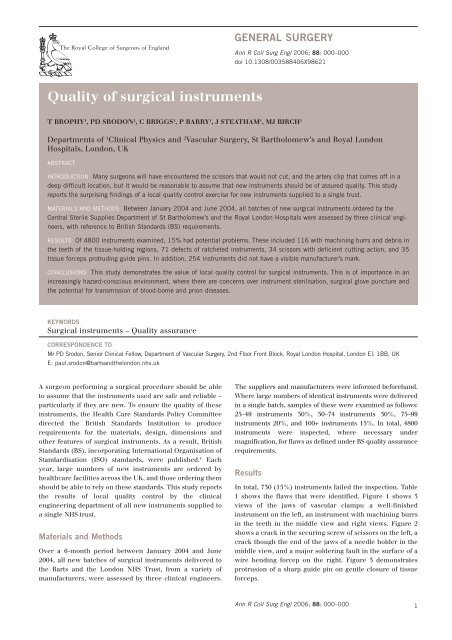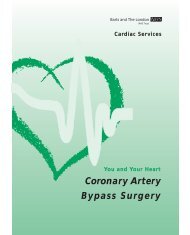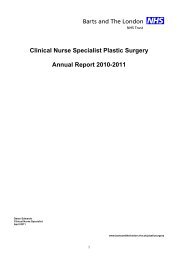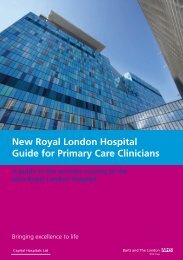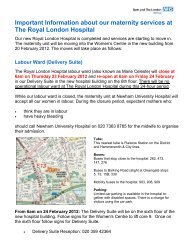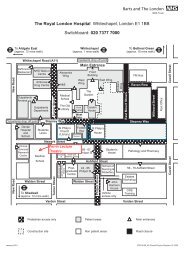Quality of surgical instruments - Barts and the London NHS Trust
Quality of surgical instruments - Barts and the London NHS Trust
Quality of surgical instruments - Barts and the London NHS Trust
Create successful ePaper yourself
Turn your PDF publications into a flip-book with our unique Google optimized e-Paper software.
The Royal College <strong>of</strong> Surgeons <strong>of</strong> Engl<strong>and</strong><br />
<strong>Quality</strong> <strong>of</strong> <strong>surgical</strong> <strong>instruments</strong><br />
A surgeon performing a <strong>surgical</strong> procedure should be able<br />
to assume that <strong>the</strong> <strong>instruments</strong> used are safe <strong>and</strong> reliable –<br />
particularly if <strong>the</strong>y are new. To ensure <strong>the</strong> quality <strong>of</strong> <strong>the</strong>se<br />
<strong>instruments</strong>, <strong>the</strong> Health Care St<strong>and</strong>ards Policy Committee<br />
directed <strong>the</strong> British St<strong>and</strong>ards Institution to produce<br />
requirements for <strong>the</strong> materials, design, dimensions <strong>and</strong><br />
o<strong>the</strong>r features <strong>of</strong> <strong>surgical</strong> <strong>instruments</strong>. As a result, British<br />
St<strong>and</strong>ards (BS), incorporating International Organisation <strong>of</strong><br />
St<strong>and</strong>ardisation (ISO) st<strong>and</strong>ards, were published. 1 Each<br />
year, large numbers <strong>of</strong> new <strong>instruments</strong> are ordered by<br />
healthcare facilities across <strong>the</strong> UK, <strong>and</strong> those ordering <strong>the</strong>m<br />
should be able to rely on <strong>the</strong>se st<strong>and</strong>ards. This study reports<br />
<strong>the</strong> results <strong>of</strong> local quality control by <strong>the</strong> clinical<br />
engineering department <strong>of</strong> all new <strong>instruments</strong> supplied to<br />
a single <strong>NHS</strong> trust.<br />
Materials <strong>and</strong> Methods<br />
Over a 6-month period between January 2004 <strong>and</strong> June<br />
2004, all new batches <strong>of</strong> <strong>surgical</strong> <strong>instruments</strong> delivered to<br />
<strong>the</strong> <strong>Barts</strong> <strong>and</strong> <strong>the</strong> <strong>London</strong> <strong>NHS</strong> <strong>Trust</strong>, from a variety <strong>of</strong><br />
manufacturers, were assessed by three clinical engineers.<br />
GENERAL SURGERY<br />
Ann R Coll Surg Engl 2006; 88: 000–000<br />
doi 10.1308/003588406X98621<br />
T BROPHY 1 , PD SRODON 2 , C BRIGGS 1 , P BARRY 1 , J STEATHAM 1 , MJ BIRCH 1<br />
Departments <strong>of</strong> 1 Clinical Physics <strong>and</strong> 2 Vascular Surgery, St Bartholomew’s <strong>and</strong> Royal <strong>London</strong><br />
Hospitals, <strong>London</strong>, UK<br />
ABSTRACT<br />
INTRODUCTION Many surgeons will have encountered <strong>the</strong> scissors that would not cut, <strong>and</strong> <strong>the</strong> artery clip that comes <strong>of</strong>f in a<br />
deep difficult location, but it would be reasonable to assume that new <strong>instruments</strong> should be <strong>of</strong> assured quality. This study<br />
reports <strong>the</strong> surprising findings <strong>of</strong> a local quality control exercise for new <strong>instruments</strong> supplied to a single trust.<br />
MATERIALS AND METHODS Between January 2004 <strong>and</strong> June 2004, all batches <strong>of</strong> new <strong>surgical</strong> <strong>instruments</strong> ordered by <strong>the</strong><br />
Central Sterile Supplies Department <strong>of</strong> St Bartholomew’s <strong>and</strong> <strong>the</strong> Royal <strong>London</strong> Hospitals were assessed by three clinical engineers,<br />
with reference to British St<strong>and</strong>ards (BS) requirements.<br />
RESULTS Of 4800 <strong>instruments</strong> examined, 15% had potential problems. These included 116 with machining burrs <strong>and</strong> debris in<br />
<strong>the</strong> teeth <strong>of</strong> <strong>the</strong> tissue-holding regions, 71 defects <strong>of</strong> ratcheted <strong>instruments</strong>, 34 scissors with deficient cutting action, <strong>and</strong> 35<br />
tissue forceps protruding guide pins. In addition, 254 <strong>instruments</strong> did not have a visible manufacturer’s mark.<br />
CONCLUSIONS This study demonstrates <strong>the</strong> value <strong>of</strong> local quality control for <strong>surgical</strong> <strong>instruments</strong>. This is <strong>of</strong> importance in an<br />
increasingly hazard-conscious environment, where <strong>the</strong>re are concerns over instrument sterilisation, <strong>surgical</strong> glove puncture <strong>and</strong><br />
<strong>the</strong> potential for transmission <strong>of</strong> blood-borne <strong>and</strong> prion diseases.<br />
KEYWORDS<br />
Surgical <strong>instruments</strong> – <strong>Quality</strong> assurance<br />
CORRESPONDENCE TO<br />
Mr PD Srodon, Senior Clinical Fellow, Department <strong>of</strong> Vascular Surgery, 2nd Floor Front Block, Royal <strong>London</strong> Hospital, <strong>London</strong> E1 1BB, UK<br />
E: paul.srodon@barts<strong>and</strong><strong>the</strong>london.nhs.uk<br />
The suppliers <strong>and</strong> manufacturers were informed beforeh<strong>and</strong>.<br />
Where large numbers <strong>of</strong> identical <strong>instruments</strong> were delivered<br />
in a single batch, samples <strong>of</strong> <strong>the</strong>se were examined as follows:<br />
25–49 <strong>instruments</strong> 50%, 50–74 <strong>instruments</strong> 30%, 75–99<br />
<strong>instruments</strong> 20%, <strong>and</strong> 100+ <strong>instruments</strong> 15%. In total, 4800<br />
<strong>instruments</strong> were inspected, where necessary under<br />
magnification, for flaws as defined under BS quality assurance<br />
requirements.<br />
Results<br />
In total, 730 (15%) <strong>instruments</strong> failed <strong>the</strong> inspection. Table<br />
1 shows <strong>the</strong> flaws that were identified. Figure 1 shows 3<br />
views <strong>of</strong> <strong>the</strong> jaws <strong>of</strong> vascular clamps: a well-finished<br />
instrument on <strong>the</strong> left, an instrument with machining burrs<br />
in <strong>the</strong> teeth in <strong>the</strong> middle view <strong>and</strong> right views. Figure 2<br />
shows a crack in <strong>the</strong> securing screw <strong>of</strong> scissors on <strong>the</strong> left, a<br />
crack though <strong>the</strong> end <strong>of</strong> <strong>the</strong> jaws <strong>of</strong> a needle holder in <strong>the</strong><br />
middle view, <strong>and</strong> a major soldering fault in <strong>the</strong> surface <strong>of</strong> a<br />
wire bending forcep on <strong>the</strong> right. Figure 3 demonstrates<br />
protrusion <strong>of</strong> a sharp guide pin on gentle closure <strong>of</strong> tissue<br />
forceps.<br />
Ann R Coll Surg Engl 2006; 88: 000–000 1
BROPHY SRODON BRIGGS BARRY STEATHAM BIRCH QUALITY OF SURGICAL INSTRUMENTS<br />
2<br />
Table 1 Identified instrument flaws<br />
Number <strong>of</strong><br />
Principal flaw <strong>instruments</strong><br />
Machining burrs in teeth 116<br />
Sharp burrs on h<strong>and</strong>le grips 8<br />
Soldering faults 47<br />
Cracks 91<br />
Failure <strong>of</strong> cutting action 34<br />
Failure <strong>of</strong> correct meshing <strong>of</strong> ratchets 71<br />
Failure <strong>of</strong> jaws <strong>of</strong> needle holders 36<br />
Protruding tissue forceps guide pins 35<br />
Corrosion 28<br />
Deficient electrical insulation 10<br />
Absent manufacturer’s mark 254<br />
Discussion<br />
The commonest fault identified was lack <strong>of</strong> a maker’s mark.<br />
BS states that ‘<strong>the</strong> instrument shall be marked with <strong>the</strong><br />
name or registered trade mark <strong>of</strong> <strong>the</strong> manufacturer or<br />
supplier’. 1 This may seem like a minor infringement, but in<br />
fact it is highly important. If an instrument fails in service, it<br />
is essential that <strong>the</strong> supplier <strong>and</strong> manufacturer can be<br />
notified, so that any potential problem can be rectified, to<br />
ensure <strong>the</strong> safety <strong>of</strong> <strong>the</strong> patient <strong>and</strong> <strong>the</strong>atre staff. In addition,<br />
<strong>the</strong>re is <strong>the</strong> question <strong>of</strong> liability <strong>and</strong> insurance.<br />
Ann R Coll Surg Engl 2006; 88: 000–000<br />
The commonest mechanical <strong>and</strong> structural fault was<br />
machining burr debris. BS states that ‘all surfaces must be<br />
free from pores, crevices <strong>and</strong> grinding marks’. 1 The fine<br />
metallic surfaces <strong>of</strong> <strong>surgical</strong> <strong>instruments</strong> are <strong>the</strong> product <strong>of</strong><br />
a number <strong>of</strong> engineering processes. The shapes <strong>and</strong> details<br />
are initially created by casting <strong>and</strong> pressing <strong>the</strong> metal into<br />
<strong>the</strong> required shape, but <strong>the</strong>n finer detail is ground in. In<br />
modern, computer-controlled, laser-guided engineering,<br />
this should be a straightforward <strong>and</strong> reliable process, producing<br />
an extremely accurate surface, as is shown in <strong>the</strong><br />
upper view <strong>of</strong> Figure 1. Sometimes, older methods are used<br />
but a fine finish should still be possible, as long as <strong>the</strong> surface<br />
is inspected <strong>and</strong> machine brush-polished. If this<br />
process is incomplete, metallic debris <strong>and</strong> surface imperfections<br />
will remain as shown in <strong>the</strong> middle view <strong>of</strong> Figure<br />
1. This may be a problem in a number <strong>of</strong> ways. First, blood<br />
<strong>and</strong> tissue debris may collect in <strong>the</strong> imperfect surface. We<br />
have traditionally relied on sterilisation procedures to render<br />
such debris inert, but <strong>the</strong>re are now concerns that prion<br />
disease may survive such processes. 2 The metallic fragments<br />
may also wear <strong>of</strong>f <strong>the</strong>se surfaces, <strong>and</strong> remain as<br />
microscopic debris in <strong>the</strong> wound. Sharp burrs on instrument<br />
h<strong>and</strong>les may contribute to previously unexplained<br />
<strong>surgical</strong> glove punctures. Although we cannot reference<br />
any reported instance <strong>of</strong> this, BS states that ‘<strong>the</strong>re shall be<br />
no sharp edges o<strong>the</strong>r than those required by <strong>the</strong> pattern <strong>of</strong><br />
<strong>the</strong> instrument’. 1<br />
Cracks <strong>and</strong> soldering faults may also provide niches for<br />
retention <strong>of</strong> blood <strong>and</strong> tissue, <strong>and</strong> serious defects may lead to<br />
instrument failure, such as <strong>the</strong> examples shown in Figure 2.<br />
Figure 1 Magnified views <strong>of</strong> <strong>the</strong> jaws <strong>of</strong> vascular clamps – a well-finished example on <strong>the</strong> left, poorly finished examples in <strong>the</strong> middle <strong>and</strong> right views.
BROPHY SRODON BRIGGS BARRY STEATHAM BIRCH QUALITY OF SURGICAL INSTRUMENTS<br />
Figure 2 Magnified views showing a crack though <strong>the</strong> screw-head <strong>of</strong> fine scissors on <strong>the</strong> left, a cracked needle holder tip in <strong>the</strong> middle, <strong>and</strong><br />
absence <strong>of</strong> solder to secure <strong>the</strong> jaw surface insert <strong>of</strong> a wire holder on <strong>the</strong> right.<br />
Every surgeon must have encountered <strong>the</strong> scissors that do<br />
not cut but, surprisingly, this can be a problem with new scissors.<br />
In this study, 34 scissors <strong>of</strong> various types did not meet <strong>the</strong><br />
simple BS requirement, which describes how wet tissue paper<br />
(for fine dissecting scissors) <strong>and</strong> no. 18 gauze (for heavy tissue<br />
<strong>and</strong> suture scissors) must be cut cleanly <strong>and</strong> without tearing,<br />
for two-thirds <strong>of</strong> <strong>the</strong> length <strong>of</strong> <strong>the</strong> cutting blades. 1<br />
Figure 3 Protrusion <strong>of</strong> a forceps’ guide pin.<br />
Most surgeons will also know <strong>the</strong> problem <strong>of</strong> <strong>the</strong> artery<br />
clip which comes <strong>of</strong>f in a deep, difficult location. Contrary<br />
to popular myth, most surgeons do criticise <strong>the</strong>ir own technique<br />
for such problems, but may now be surprised to find<br />
that we identified 71 ratchet problems in new artery clips.<br />
BS describes in detail how <strong>the</strong> racks <strong>of</strong> <strong>the</strong>se <strong>instruments</strong><br />
should function so that <strong>the</strong>y ‘mate accurately when<br />
Ann R Coll Surg Engl 2006; 88: 000–000 3
BROPHY SRODON BRIGGS BARRY STEATHAM BIRCH QUALITY OF SURGICAL INSTRUMENTS<br />
engaged’, 1 <strong>and</strong> should not spring open when left closed for<br />
3h on a test wire <strong>of</strong> specified diameter. The <strong>instruments</strong><br />
that failed our assessments all had racks that did not engage<br />
correctly, <strong>and</strong> sprang open when tested in this way.<br />
Many fine tissue forceps have guide pins to re-inforce<br />
<strong>the</strong> accuracy <strong>of</strong> <strong>the</strong> jaws mating. BS states that ‘if present,<br />
<strong>the</strong> guide pin shall be tapered to facilitate entry into <strong>the</strong><br />
locating hole <strong>and</strong> shall not protrude from <strong>the</strong> hole when <strong>the</strong><br />
jaws are closed’. 1 We identified 35 guide pins which protruded<br />
on light, but complete, closure <strong>of</strong> <strong>the</strong> forceps’ jaws<br />
on naked eye inspection. This may be a source <strong>of</strong> glove<br />
puncture.<br />
The stainless steel alloy from which modern <strong>instruments</strong><br />
are made must also conform to BS. Procedures are<br />
described to test corrosion resistance, but it surprised us to<br />
find visible corrosion on new <strong>instruments</strong>.<br />
4<br />
Ann R Coll Surg Engl 2006; 88: 000–000<br />
Conclusions<br />
This study demonstrates <strong>the</strong> value <strong>of</strong> local quality control for<br />
new <strong>surgical</strong> <strong>instruments</strong>. We have found a significant number<br />
<strong>of</strong> cases where new <strong>instruments</strong> did not appear to meet<br />
appropriate st<strong>and</strong>ards, <strong>and</strong> have discussed <strong>the</strong> potential<br />
problems that may result. It must be stressed that we have not<br />
shown any specific instance <strong>of</strong> harm to a patient or staff<br />
through <strong>the</strong>se defects. Suppliers were informed, <strong>and</strong> remedial<br />
action taken. All defective <strong>instruments</strong> were replaced <strong>and</strong> reexamined<br />
prior to entering service.<br />
References<br />
1. British St<strong>and</strong>ards Institution. The British St<strong>and</strong>ard. BS 5194, parts 1–4.<br />
<strong>London</strong>: British St<strong>and</strong>ards Institution, 1985. ISBN 0 580 14853 X.<br />
2. Collinge J. Variant Creutzfeldt-Jakob disease. Lancet 1999; 354: 317–23.<br />
3. Lemmer K, Mielke M, Pauli G, Beekes M. Decontamination <strong>of</strong> <strong>surgical</strong> <strong>instruments</strong><br />
from prion proteins: in vitro studies on <strong>the</strong> detachment, destabilization<br />
<strong>and</strong> degradation <strong>of</strong> PrPSc bound to steel surfaces. J Gen Virol 2004; 85:<br />
3805–16.


